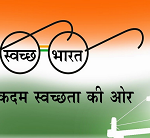When the celebrations of the Aam Admi Party’s win in Delhi’s elections are over, there will be hard work to do. Fulfilling the agenda of prioritizing fair pricing and supply of water and electricity is key, but so are Delhi’s myriad problems like women’s safety, pollution, cleanliness and waste disposal. Solving these will not be easy, and AAP’s disruptive innovation in this quarter will be watched closely by the rest of the country seeking similar solutions.
One way to accelerate the process will be to involve citizens through a massive public messaging programme. The party’s intense grassroots engagement with the man-on-the-street will make this far easier to achieve than Prime Minister Modi’s lead-from-the-front campaigns like Swacch Bharat, Clean Ganga, Digital India.
Six months into those campaigns, there is little apart from Mr. Modi himself reinforcing the issues. Swacch Bharat is expected to spend Rs. 62,000 crores over five years, with the involvement of the states, the centre, and several ministries. But so far, Modi’s is the most visible face of the government-endorsed programmes, and only viewers of Doordarshan can see them in full spectrum. The private sector has adopted only those that bring them business. The social messaging that is needed to truly change India, is simply not evident in the public space.
AAP can use its catchment of citizens and youth to champion the transformation of behavior patterns entrenched for centuries – and Delhi can become a model for the rest of India. What is required is relentless public awareness messaging to inculcate appropriate attitude and behavior, through hoardings, adverts in transportation hubs, in slums and bastis, schools, on the radio, in public and private offices, which will trigger the desired responses.
This is not difficult to do. It requires vision, persistence, diligence and some money. Countries around the world have successfully conducted similar campaigns, and progressed – Singapore and Australia with cleanliness, South Africa with aids, the US with terrorism, U.K. with cleaning the Thames.
Till 15 years ago, it was not uncommon to see signs in office buildings in Singapore that said “Do not urinate in the elevator.” The country is now a model of sparkling Asian cleanliness. But it began its journey to Keep Singapore Clean in 1968, and persisted with it. The campaign was championed by Prime Minister Lee Kuan Yew[1] himself, with the goal of improving the quality of life for Singaporeans, attracting tourists and foreign investment. The campaign had nationalistic tones, aiming to instill a sense of national pride and build social cohesion around a valued public good i.e. clean public spaces. A committee headed by the health minister was appointed to lead the campaign, and included government representatives and NGOs.[2] Its awareness campaign involved public education activities such as lectures and competitions.
Additionally, the Environmental Public Health Act was introduced, making littering a punishable offence.[3] Lee Kuan Yew encouraged grassroots action, but was clear about imposing consequences to discourage undesirable behaviour. There were diligent inspections by government bodies, fines for littering, and even public shaming.
Today, 47 years later, the campaign is spearheaded by Singapore’s National Environment Agency (NEA), and carried out on an annual basis. Public cleaning is mechanised and conducted mainly by contractors engaged by the NEA.[4] Awareness campaigns, such as Let’s Bin It! encourage citizens to take responsibility.[5]
But Singapore is small, just 5 million – a fifth of Delhi’s population. Establishing a cleanliness culture in a city of 25 million – and in a country of 1.2 billion – is a mammoth task. Solutions will require sensitivity to cultural and social dynamics like caste, poverty and corruption.
When the next chief minister in Delhi is sworn into office, an immediate task will be to address issues of women’s safety, cleanliness, pollution. Beyond the endorsements and speeches, what’s needed is:
- 1. Creation of an ecosystem which thrives beyond any single administration – for instance, by transitioning the campaign to one or more ministries.
- 2. Top-down, comprehensive national strategy including legislative support, enforcement mechanisms, capacity building, reliable public services.
- 3. Bottom-up activities such as public education, civic activities, student outreach.
- 4. Long term scaling up, diversification and maintenance of the campaign using regular evaluations, surveys and studies by different stakeholders to continually improve.
It’s time to change India’s bad habits. A historic opportunity to alter social behavior was lost in 2012 after the Delhi rape case. What better place to make amends and reignite youthful energies than the new, citizen-centric AAP in Delhi 2015?
Manjeet Kripalani is the co-founder and executive director of Gateway House: Indian Council on Global Relations, Mumbai.
Reetika Joshi is Senior Manager for Special projects & Outreach at Gateway House.
A shorter version of this article was published in the Live Mint newspaper.
This article was exclusively written for Gateway House: Indian Council on Global Relations. You can read more exclusive content here.
For interview requests with the author, or for permission to republish, please contact outreach@gatewayhouse.in.
© Copyright 2015 Gateway House: Indian Council on Global Relations. All rights reserved. Any unauthorized copying or reproduction is strictly prohibited
[1] Joshua Chia Yeong Jia and Lim Tin Seng, Keep Singapore Clean Campaign, Singapore Infopedia, 2008, http://eresources.nlb.gov.sg/infopedia/articles/SIP_1160_2008-12-05.html
[2] Ibid 1.
[3] National Environment Agency, Towards a Cleaner Singapore: A Sociological Study of Littering in Singapore, Paulin Tay Straughan, Narayanan Ganapathy, Daniel Goh, Everold Hosein, 2011, p15, http://www.publichygienecouncil.sg/docs/default-source/default-document-library/towards-a-cleaner-singapore-%28final%29.pdf?sfvrsn=2
[4] Ibid 3, p8.
[5] Ibid 3, p11.


